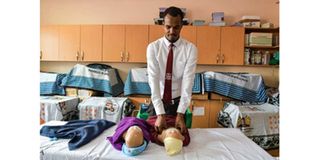Why gender norms can't stop Migori student's midwifery journey

Mohamed Yunis, a nursing student at KMTC, Migori, demonstrates how to resuscitate a newborn using a baby mannequin.
What you need to know:
- Yunis believes he has the calling to serve, and it is something he started to feel strongly about while in high school.
- He acknowledges that he will face a Herculean task in challenging gender norms as people from his home area have yet to embrace male midwives.
A sharp scream cuts through the air inside the Migori County Referral Hospital maternity ward. A woman is in labour. Adjacent to the delivery room, two new mothers nurse their babies.
Just a few hours prior, they, too, were wailing, but that pain had been quickly forgotten. Mohamed Yunis, a Third Year nursing student, has been up and down the delivery room since 7.30am when he reported. He is eager to learn all that he can, before getting out into the real world.
It was in 2020 that Mohamed made the decision to become a midwife. "I believe I have the calling to serve, and it is something I started to feel strongly about while in high school."
When he received his admission letter to join the Kenya Medical Training College, Migori campus, his father was hesitant. Among other things, he felt that it was just too far away from his hometown in Garissa County. But Mohamed could not let this opportunity slip away.
“Over the years, I have heard of many women who have lost their lives during the birthing process. I would like to contribute in one way or another in remedying this problem in my community."
Data indicates that in 2008, there were 5,000 maternal deaths for every 100,000 live births in Garissa. By 2013, that number had dropped to 3,900, and by 2018, it had further decreased to 500.

Migori County Referral Hospital Nurse Mary Khaemba directs Mohamed Yunis, a nursing student at the KMTC in Migori, on how to resuscitate a newborn using a baby mannequin.
After three years of study, and interruptions due to Covid-19, Mohamed has only a month left before he sits his final exam. He is grateful to his brothers who are in the medical field for encouraging him to follow his dreams.
He acknowledges that he will face a Herculean task in challenging gender norms and reshaping the landscape of maternity care as a male midwife.
"Back home, especially in the rural areas, many women will not agree to be attended to by a male midwife who hails from the same tribe as them because they say it is against our culture. But they forget we are professionals like any other.
“I have my work cut out for me, but I hope to collaborate with different individuals and groups to raise awareness of the role of midwives in the hope of reducing home births, which contribute to the high maternal deaths in my county," he says.
In future, Mohamed wants to specialise in anaesthesia. His advice to youth who want to take up midwifery and nursing in general is to only do it if they have a passion for helping people.
"We are the heartbeat of hospitals. The biggest lesson I have learnt is that you have to have a heart for the people, to be able to work diligently and provide quality care to patients."





